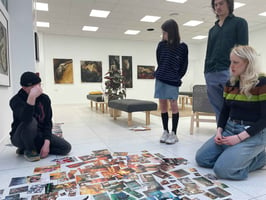Explore how individuals with Asperger’s Syndrome harness their unique perspective and abilities to...
SPD's Impact on Artistic Vision

Explore how Sensory Processing Disorder shapes and influences the creative landscape, transforming challenges into unique artistic expressions.
Heightened Sensory Awareness in Artistic Creation
Individuals with Sensory Processing Disorder (SPD) often perceive the world with an intensity that the average person may not experience. This heightened sensory awareness can make them acutely attuned to the subtleties of textures, colors, sounds, or lights. While such sensitivity can be overwhelming, it also offers a unique perspective that can be channeled into creative endeavors. Artists with SPD may produce visual art that is strikingly vibrant, as they capture nuances that escape others. Sculptures may carry a depth of texture that invites tactile exploration, and musical compositions might feature richly layered soundscapes that evoke a strong emotional response.
This intense perception often leads to a distinct and intricate expression in art. The way an artist with SPD interacts with their medium is deeply informed by their sensory experiences, often resulting in works that stand out for their attention to detail and sensory richness. It's this profound connection to their senses that can make their art exceptionally communicative, resonating with others on a sensory level.
Navigating Sensory Challenges Through Creative Solutions
Artists with Sensory Processing Disorder (SPD) face unique challenges when it comes to creating art. The heightened sensitivity to certain materials or environmental factors can create discomfort and hinder the artistic process. However, these individuals often display incredible ingenuity by adapting their methods to overcome these obstacles. They may experiment with different media that align with their sensory preferences or customize their workspaces to create a more sensory-friendly environment. For example, an artist with SPD might opt for hypoallergenic materials or utilize tools that alleviate physical discomfort.
These innovative solutions not only enable artists with SPD to continue their creative pursuits without sensory distress but also lead to the development of new and groundbreaking practices. In pushing the boundaries of traditional artistic methods, these individuals become trailblazers in their respective fields, finding innovative ways to convey their artistic vision while honoring their sensory needs. Their adaptability serves as a testament to their resilience and resourcefulness, showcasing the remarkable ability of artists with SPD to navigate challenges and thrive in their creative endeavors.
Art as a Therapeutic Outlet for SPD
Art therapy offers individuals with Sensory Processing Disorder (SPD) a transformative space where art becomes a powerful tool for healing and self-discovery. Through engaging in artistic activities, individuals with SPD can find solace in a controlled environment that allows them to manage and manipulate sensory input according to their needs. This intentional manipulation of sensory experiences not only provides a sense of relief from the overwhelming stimuli but also fosters a sense of empowerment and agency over their sensory world.
Within the realm of art therapy, individuals with SPD can explore and navigate their sensory responses in a safe and supportive setting. The creative process becomes a refuge, offering a sanctuary where they can express themselves authentically and delve into the depths of their emotions. Through the act of creating, individuals with SPD can process and make sense of their sensory information, leading to a deeper understanding of themselves and their unique sensory experiences.
Art therapy is a recognized and valuable tool for individuals with SPD, as it goes beyond traditional therapeutic approaches by utilizing the creative process to support sensory integration and emotional well-being. By tapping into the expressive and transformative power of art, individuals with SPD can embark on a journey of self-discovery, personal growth, and healing. In this way, art therapy becomes a beacon of hope and healing for those navigating the complexities of Sensory Processing Disorder, offering a pathway towards greater self-awareness, resilience, and well-being.
Innovative Adaptations in Artistic Methods for SPD
Artists with Sensory Processing Disorder (SPD) are true pioneers in the artistic world, constantly pushing the boundaries of traditional methods to create innovative and captivating works of art. Driven by the need to cater to their unique sensory preferences, these individuals embark on a journey of exploration and experimentation, leading to groundbreaking adaptations in their artistic practices.
One of the ways in which artists with SPD innovate is through the use of unconventional materials that align with their sensory profiles. By thinking outside the box and exploring new textures, colors, and forms, they are able to create art that not only resonates with their own sensory experiences but also captivates and engages audiences in ways that traditional art may not.
Furthermore, artists with SPD are at the forefront of creating interactive art that invites viewers to engage with their work on a sensory level. By incorporating elements of touch, sound, and movement into their pieces, they offer a multi-sensory experience that transcends the boundaries of traditional art forms. This interactive approach not only challenges the norms of the art world but also invites a broader audience to connect with and appreciate art in a more immersive and engaging way.
Ultimately, the innovative adaptations made by artists with Sensory Processing Disorder not only benefit the creators themselves by allowing them to fully express their unique sensory experiences but also enrich the art world as a whole by introducing fresh perspectives and techniques. Through their groundbreaking art, these individuals not only push the boundaries of artistic mediums but also offer a glimpse into the rich and complex world of sensory perception, providing new insights and perspectives on the human experience.
Advocacy and Awareness Through Art
Artists with Sensory Processing Disorder not only excel in their creative endeavors but also serve as powerful advocates for raising awareness about the condition through their art. Their unique sensory experiences become a medium for initiating important conversations and fostering understanding among individuals. By delving into the intricacies of sensory perception through their artistic expressions, these artists offer a glimpse into a world that is often misunderstood or overlooked.
The impact of their artwork extends beyond aesthetics, as it has the potential to evoke empathy and educate the public on the diverse ways in which individuals experience the world. Through their personal narratives conveyed in art, these individuals play a vital role in dismantling stereotypes and promoting a more inclusive society that values and respects sensory diversity. Their creative endeavors not only serve as a means of self-expression but also as a catalyst for social change, sparking conversations and encouraging a deeper appreciation for the complexities of Sensory Processing Disorder.
In utilizing art as a platform for advocacy, these artists with SPD are instrumental in shaping a more empathetic and informed society. Their willingness to share their unique perspectives and sensory experiences through art not only sheds light on the challenges they face but also highlights the beauty and richness that comes with sensory diversity. By weaving their personal stories into their art, these individuals contribute to a broader dialogue on sensory differences, ultimately paving the way for a more inclusive and understanding world.



